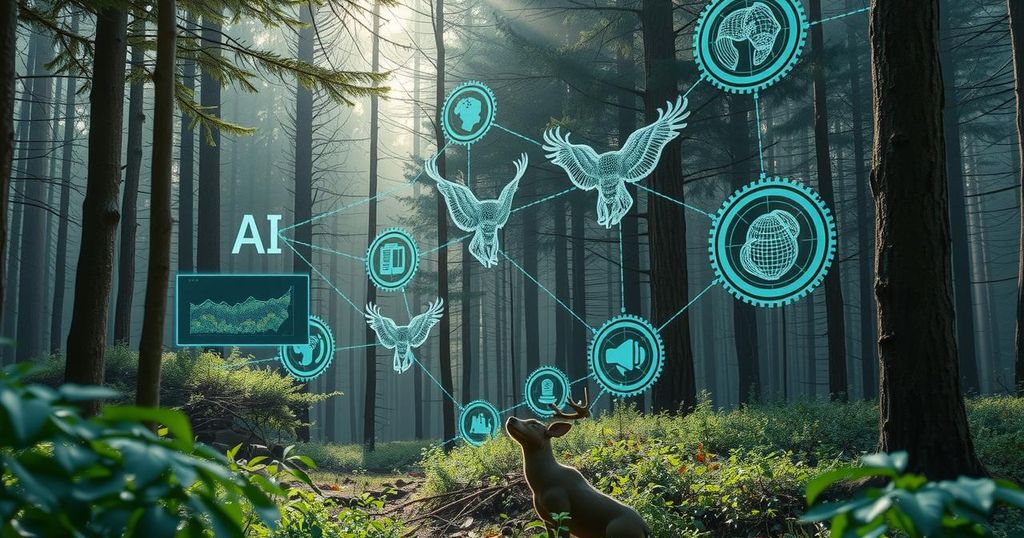AI
ARTIFICIAL INTELLIGENCE, ASIA, BUSINESS MANAGEMENT OF NATURAL RESOURCES, CLIMATE CHANGE, COLUMBIA, ENVIRONMENTAL IMPACT, HAMISH VAN DER VEN, INDIA, JIM ROBBINS, NATURE, NORTH AMERICA, SCIENCE_TECHNOLOGY, SUSTAINABILITY, UNITED STATES, UNIVERSITY OF BRITISH, UNIVERSITY OF BRITISH COLUMBIA, YALE, YELLOWSTONE
Nina Oliviera
0 Comments
AI Transforms Wildlife Research Yet Raises Concerns Over Field Experience
AI is revolutionizing wildlife research, processing massive datasets to uncover important animal behaviors. However, there’s a growing concern that this shift could detach scientists from direct field experiences and degrade the value of Indigenous ecological knowledge. Balancing advanced tech with essential hands-on observation is crucial, as AI might reinforce biases against traditional conservation methods.
Artificial intelligence is making waves in the wildlife research scene, and it’s hard to ignore its impact. Researchers are tapping into AI tools to sift through mountains of audio and visual data, uncovering behaviors and habitat patterns that were previously elusive. This means studying creatures like the common nighthawk, which are often active only at night, isn’t such a puzzle anymore. From the sprawling landscapes of Yellowstone to regions in India, researchers are turning to AI to take stock of species, monitor gunfire, and even foresee ecological changes. But there’s a flip side to this tech takeover.
Some experts are sounding the alarm. While AI offers nifty solutions to complex wildlife issues, critics argue that this digital revolution could undermine traditional fieldwork and Indigenous knowledge. It’s like trying to understand a deep sea without ever getting wet. The concern is that the AI-driven methods, mostly based on data from Western sources, could skew our understanding of nature and push aside traditional ecological wisdom. Conservationists are worried that a reliance on algorithms could lead to a disconnection from the very environment they’re trying to protect.
As AI strides into the realm of biodiversity, we must tread carefully. This technology allows for the analysis of a staggering amount of information — hundreds of thousands of camera trap photos and audio recordings from the wild, all of which can help inform critical decisions. Quick analyses can be vital when considering measures like hunting quotas or tracking wildlife diseases. Yet, as the digital age sweeps in, we must ponder whether field experience and observations, the cornerstones of biology, are being overshadowed. Not to mention, if we let AI set the agenda, we risk clinging to a myopic view of reality.
The input from people who have lived with the land for generations is invaluable. The fear is that as conservationists lean heavily on technology for efficiency, the depth of hands-on ecological observation may well fade away. In this rush toward a shiny, tech-centric future, we shouldn’t overlook what makes us human — our connection to the natural world.
As Hamish van der Ven from the University of British Columbia puts it, “If I could wave a wand and un-invent AI, I would.” It’s a stark reminder of the slippery slope we might be on. AI is revolutionizing our approaches to understanding and protecting biodiversity, but we need to take a step back. Trade-offs are truly worth discussing. As the goal of understanding and conserving nature remains paramount, the balance between advanced technology and authentic field experience is crucial to preserving this dynamic relationship. So, while we embrace these advancements, let’s keep a watchful eye on what could slip through the cracks of innovation.
In summary, AI is undeniably reshaping wildlife research and opens doors for analyzing data like never before. However, this newfound efficiency raises important questions about the future of fieldwork and the potential losses of personal observation. Experts urge us not to forget the rich wisdom of Indigenous knowledge and hands-on experience with nature, as we dive headfirst into a tech-driven era.
Original Source: www.ehn.org




Post Comment